1998 CADILLAC ELDORADO wheel
[x] Cancel search: wheelPage 87 of 380
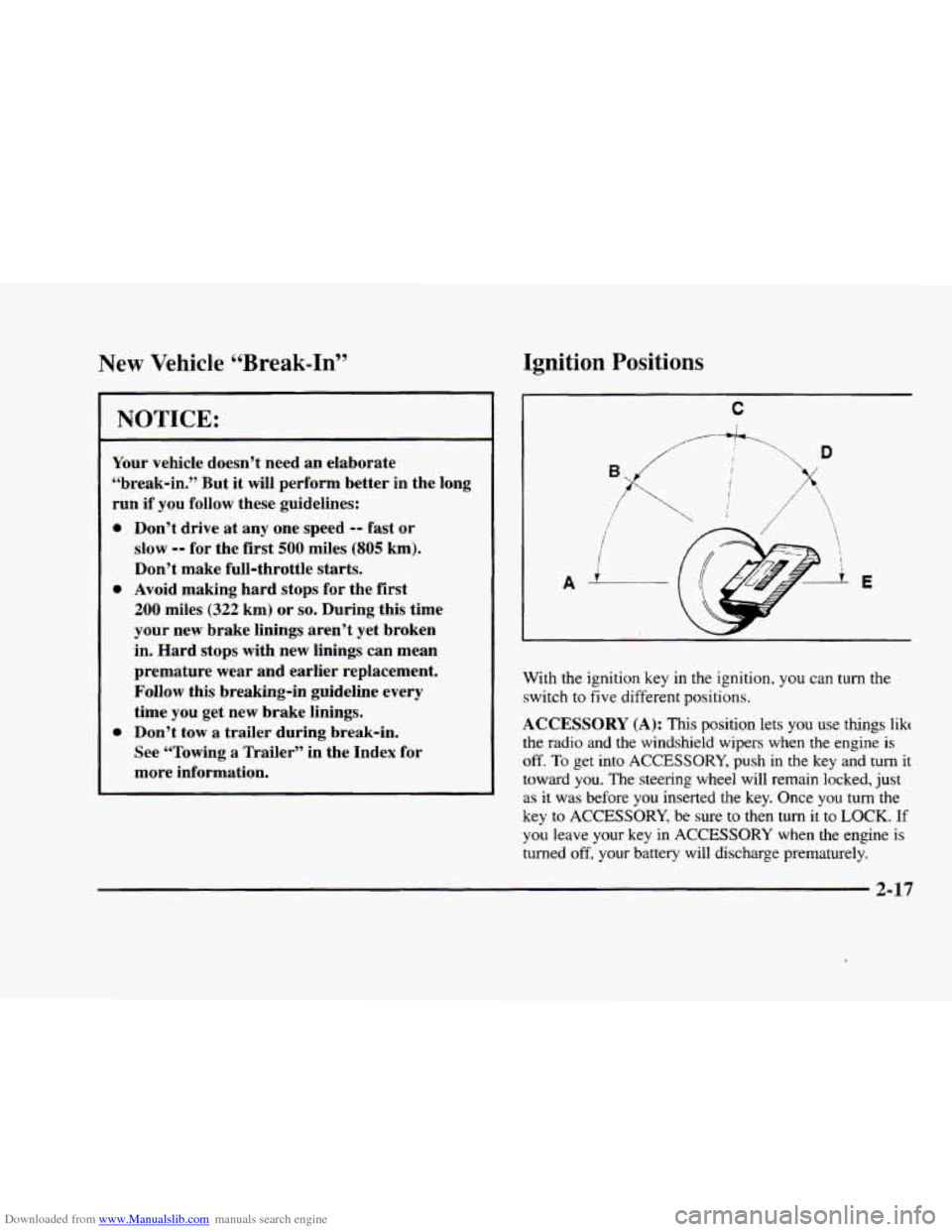
Downloaded from www.Manualslib.com manuals search engine New Vehicle “Break-In” Ignition Positions
NOTICE:
Your vehicle doesn’t need an elaborate
“break-in.” But it will perform better in the long
run if you follow these guidelines:
0
0
0
Don’t drive at any one speed -- fast or
slow
-- for the first 500 miles (805 km).
Don’t make full-throttle starts.
Avoid making hard stops for the first
200 miles (322 km) or so. During this time
your new brake linings aren’t yet broken
in. Hard stops with new linings can mean
premature wear and earlier replacement.
Follow this breaking-in guideline every
time you get new brake linings.
Don’t tow a trailer during break-in.
See “Towing
a Trailer” in the Index for
more information.
C
i
i
A L E
With the ignition key in the ignition, you can turn the
switch to five different positions.
ACCESSORY (A): This position lets you use thmgs likt
the radio and the windsheld wipers when the engine is
off. To get into ACCESSORY, push in the key and turn it
toward you. The steering wheel will remain locked, just
as it was before you inserted the key. Once you turn the
key
to ACCESSORY, be sure to then turn it to LOCK. If
you leave your key in ACCESSORY when the engine
is
turned off, your battery will discharge prematurely.
2-17
Page 88 of 380

Downloaded from www.Manualslib.com manuals search engine LOCK (B): Before you put the key in, the ignition will
be in LOCK. This
is the only position in which you can
remove the key. This position
locks the ignition, steering
wheel and transaxle. It’s a theft-deterrent feature.
NOTICE:
If your key seems stuck in LOCK and you can’t
turn it,
be sure you are using the correct key; if
so, is it all the way in? If it is, then turn the
steering wheel left and right while you turn the
key hard. But turn the key only with your hand.
Using
a tool to force it could break the key or the
ignition switch.
If none of this works, then your
vehicle needs service.
OFF (C): This position lets you turn off the engine but
still turn the steering wheel. It doesn’t lock the steering
wheel like LOCK does. Use
OFF if you must have your
vehicle in motion while the engine
is off (for example, if
your vehicle is being pushed).
RUN (D): This is the position for driving.
START (E): This position starts the engine.
Retained Accessory Power (RAP)
The following accessories on your vehicle may be used
for up
to 10 minutes after the ignition key is turned from
RUN to OFF, and then to LOCK:
0 Radio
Power Windows
Astroroof
Power to these accessories stops after
10 minutes or if
either door is opened. If you want power for another
10 minutes, turn the ignition key to RUN, OFF and
then
to LOCK.
NOTICE:
When using RAP, always leave your key in
LOCK. If you leave your key in any other
position than
LOCK, your battery will discharge
prematurely.
2-18
Page 91 of 380

Downloaded from www.Manualslib.com manuals search engine To Use the Engine Coolant Heater
1. Turn off the engine.
2. Open the hood and unwrap the electrical cord.
3. Plug it into a normal, grounded 11 0-volt AC outlet.
A CAUTION:
Plugging the cord into an ungrounded outlet
could cause
an electrical shock. Also, the wrong
kind
of extension cord could overheat and cause
a fire. You could be seriously injured. Plug the
cord into a properly grounded three-prong
110-volt
AC outlet. If the cord won’t reach, use a
heavy-duty three-prong extension cord rated for
at least 15 amps.
4. Before starting the engine, be sure to unplug
and store the cord as
it was before to keep it
away from moving engine parts. If you don’t. it
could be damaged. How
long should
you keep the coolant heater plugged
in? The answer depends on the outside temperature, the
kind
of oil you have, and some other things. Instead of
trying to list everything here, we ask that you contact
your dealer
in the area where you’ll be parking your
vehicle. The dealer can give you the best advice for that
particular area.
Automatic Transaxle Operation
P
R
N
0
3
2
1
There are several different
positions for the shift lever.
PARK (P): This position locks the front wheels. It’s the
best position
to use when you start the engine because
your vehicle can’t move easily.
2-21
Page 93 of 380
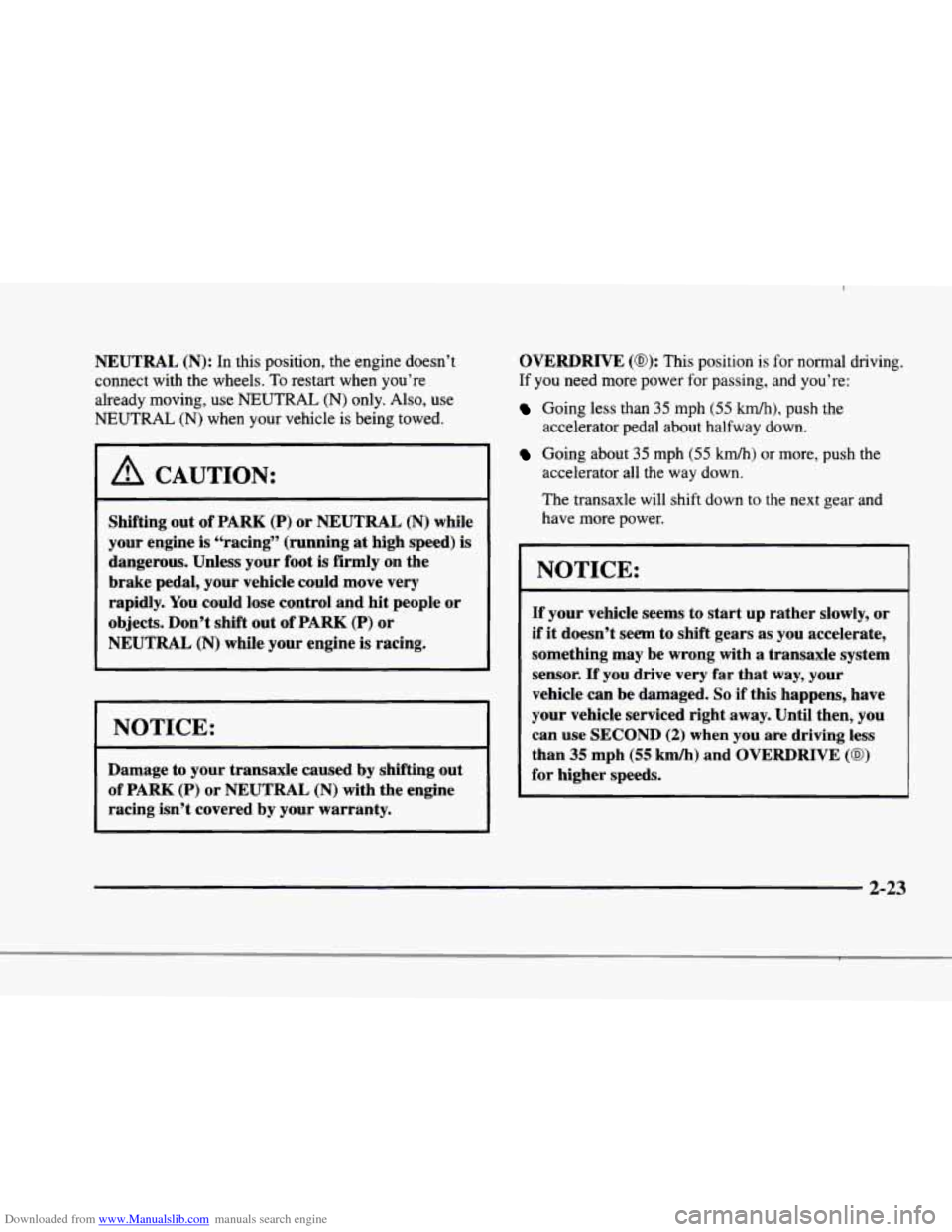
Downloaded from www.Manualslib.com manuals search engine p“
i f
r
#-
I
1
r
r
r
NEUTRAL (N): In this position, the engine doesn’t
connect with the wheels.
To restart when you’re
already moving, use NEUTRAL
(N) only. Also, use
NEUTRAL (N) when your vehicle is being towed.
A CAUTION:
Shifting out of PARK (P) or NEUTRAL (N) while
your engine
is “racing” (running at high speed) is
dangerous. Unless your foot
is firmly on the
brake pedal, your vehicle could move very
rapidly. You could lose control and hit people or
objects. Don’t shift out of
PARK (P) or
NEUTRAL
(N) while your engine is racing.
NOTICE:
~~
Damage to your transaxle caused by shifting out
of PARK (P) or NEUTRAL (N) with the engine
racing isn’t covered by your warranty.
OVERDRIVE (@): This position is for normal driving.
If you need more power for passing, and you’re:
Going less than 35 mph (55 km/h), push the
Going about 35 mph (55 km/h) or more, push the
accelerator
pedal about halfway down.
accelerator
all the way down.
The transaxle will shift down to the next gear and
have more power.
I
NOTICE:
d
If your vehicle seems to start up rather slowly, or
if
it doesn’t seem to shift gears as you accelerate,
something may be wrong with a transaxle system
sensor.
If you drive very far that way, your
vehicle can be damaged.
So if this happens, have
your vehicle serviced right away. Until then, you
can use
SECOND (2) when you are driving less
than 35 mph (55 km/h) and OVERDRIVE (0)
for higher speeds.
2-23
Page 94 of 380
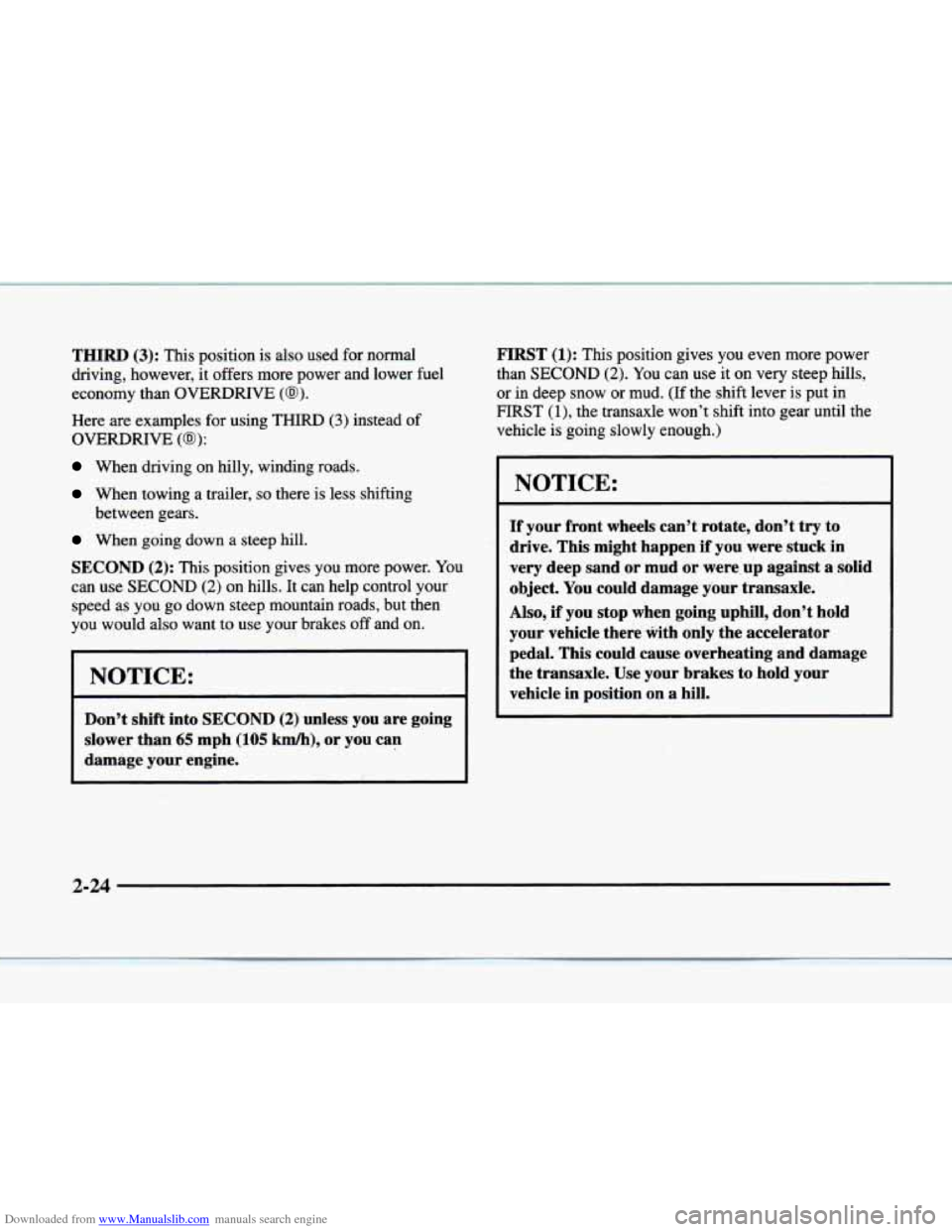
Downloaded from www.Manualslib.com manuals search engine THIRD (3): This position is also used for normal
driving, however, it offers more power and lower fuel
economy than
OVERDRIVE (@).
Here are examples for using THIRD (3) instead of
OVERDRIVE (0):
When driving on hilly, winding roads.
When towing a trailer, so there is less sh
When going down a steep hill.
between gears.
[ifting
SECOND (2): This position
gives you more power. You
can use SECOND (2) on hills. It can help control your
speed as you
go down steep mountain roads, but then
you would also want to use your brakes off and on.
~-
NOTICE:
~~~ ~~ ~~~~
Don’t shift into SECOND (2) unless you are going
slower than
65 mph (105 km/h), or you can
damage your engine.
FIRST (1): This position gives you even more power
than SECOND (2). You can use it on very steep hills,
or
in deep snow or mud. (If the shift lever is put in
FIRST
(l), the transaxle won’t shift into gear until the
vehicle is going slowly enough.)
NOTICE:
If your front wheels can’t rotate, don’t try to
drive. This might happen
if you were stuck in
very deep sand or mud or were~up against a solid
object. You could damage your transaxle.
Also,
if you stop when going uphill, don’t hold
your vehicle there with
only the accelerator
pedal. This could cause overheating and damage
the transaxle. Use your brakes to hold your
vehicle in position on a hill.
Page 101 of 380
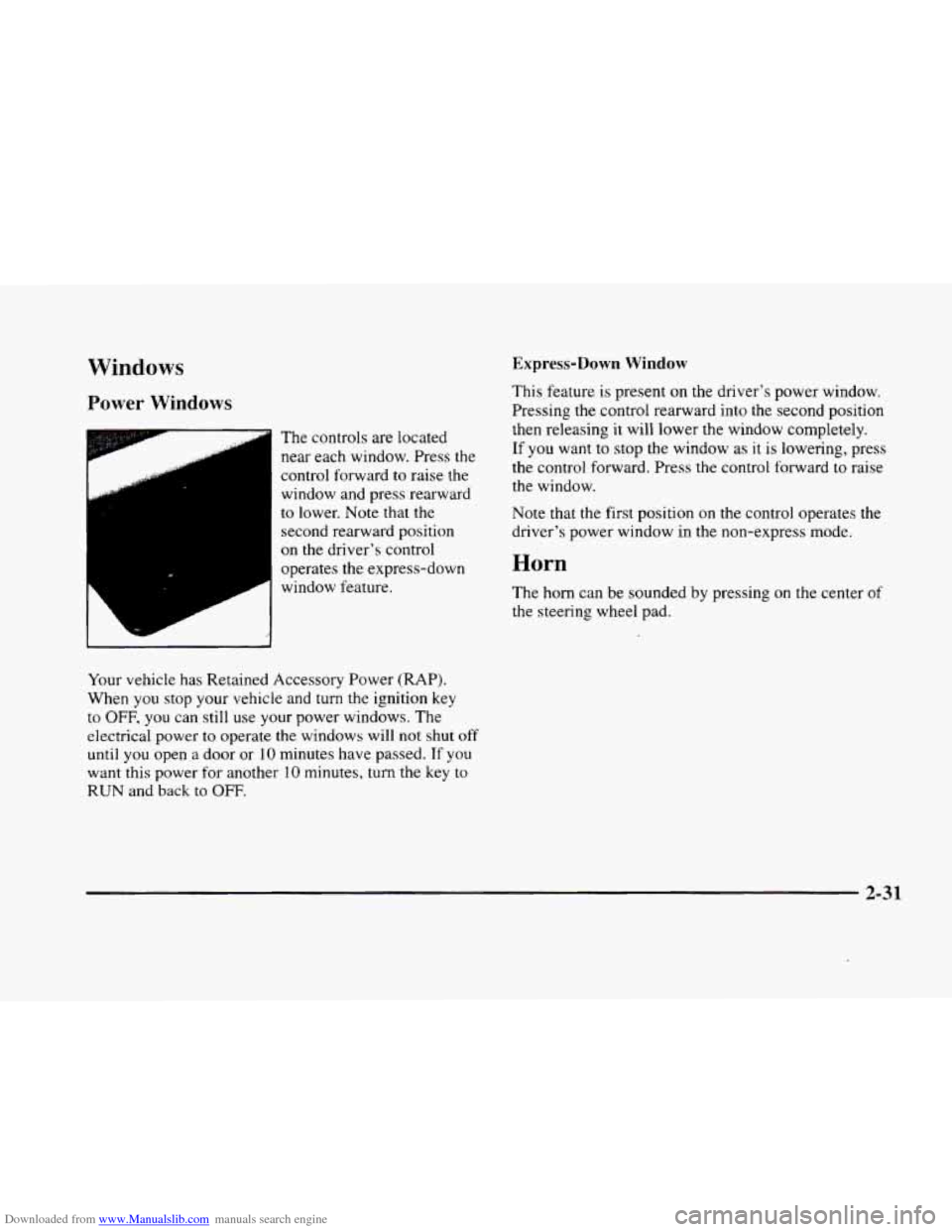
Downloaded from www.Manualslib.com manuals search engine Windows Express-Down Window
Power Windows
F-
,.. .
The controls are located
near each window. Press the
control forward
to raise the
window and press rearward
to lower. Note that the
second rearward position
on the driver's control
operates the express-down
window feature.
Your vehicle has Retained Accessory Power
(RAP).
When you stop your vehicle and turn the ignition key
to
OFF, you can still use your power windows. The
electrical power
to operate the windows will not shut off
until you open a door or 10 minutes have passed. If you
want this power for another
10 minutes, turn the key to
RUN and back to OFF.
This feature is present on the driver's power window.
Pressing the control rearward into the second position
then releasing
it will lower the window completely.
If you want to stop the window as it is lowering, press
the control forward. Press the control forward
to raise
the window.
Note that the first position
on the control operates the
driver's power window in the non-express mode.
Horn
The horn can be sounded by pressing on the center of
the steering wheel pad.
2-31
Page 102 of 380
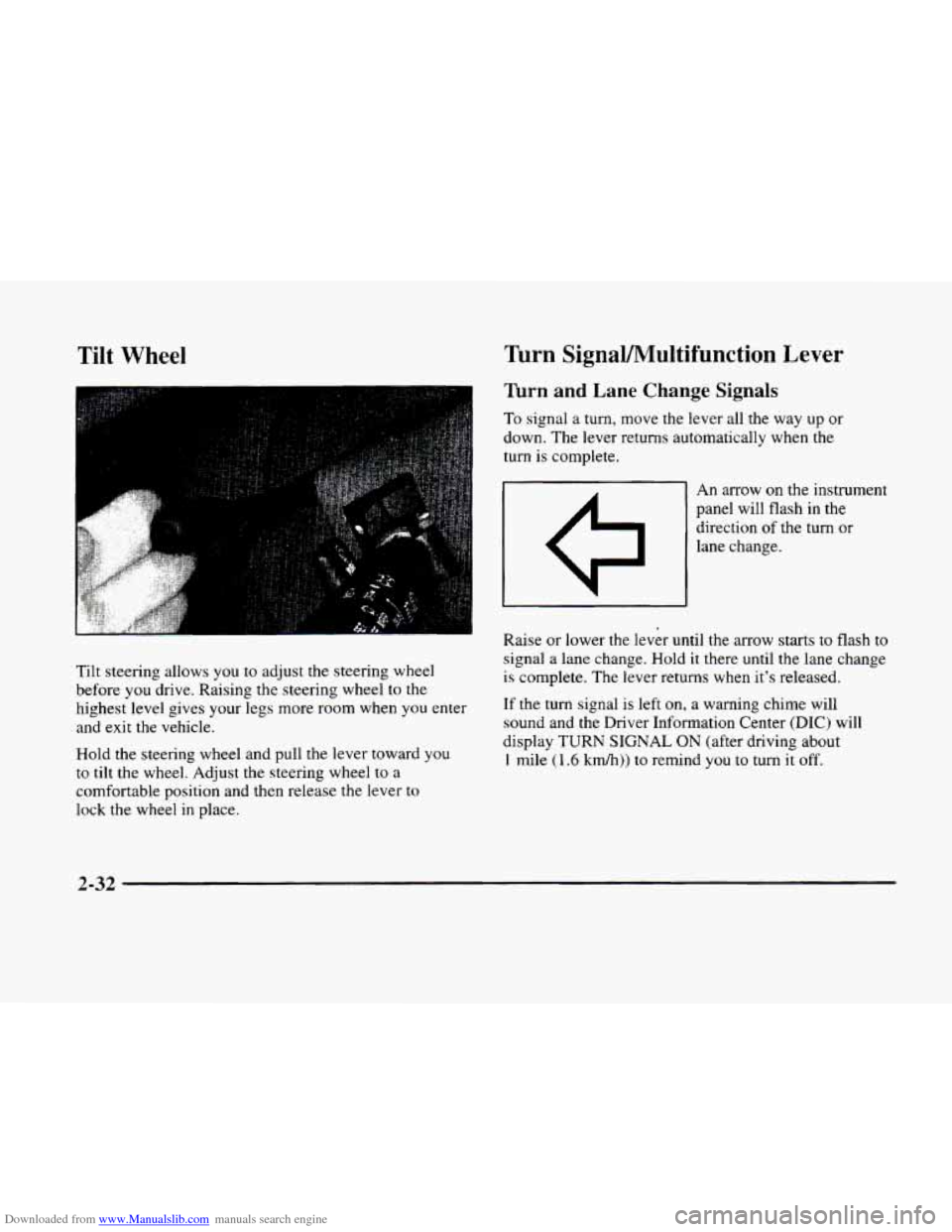
Downloaded from www.Manualslib.com manuals search engine Tilt Wheel
... .,
Tilt steering allows you to adjust the steering wheel
before
you drive. Raising the steering wheel to the
highest level gives your legs more room when you enter
and exit the vehicle.
Hold the steering wheel and pull
the lever toward you
to tilt the wheel. Adjust the steering wheel to a
comfortable position and then release the lever to
lock the wheel in place.
Turn SignaVMultifunction Lever
Turn and Lane Change Signals
To signal a turn, move the lever all the way up or
down, The lever returns automatically when the
turn is complete.
I 1
c7
An arrow on the instrument
panel will flash
in the
direction
of the turn or
lane change.
Raise
or lower the lever until the arrow starts to flash to
signal a lane change. Hold it there until the lane change
is complete. The lever returns when it's released.
If the turn signal is left on, a warning chime will
sound and the Driver Information Center
(DIC) will
display
TURN SIGNAL ON (after driving about
1 mile (1.6 km/h)) to remind you to turn it off.
2-32
Page 106 of 380
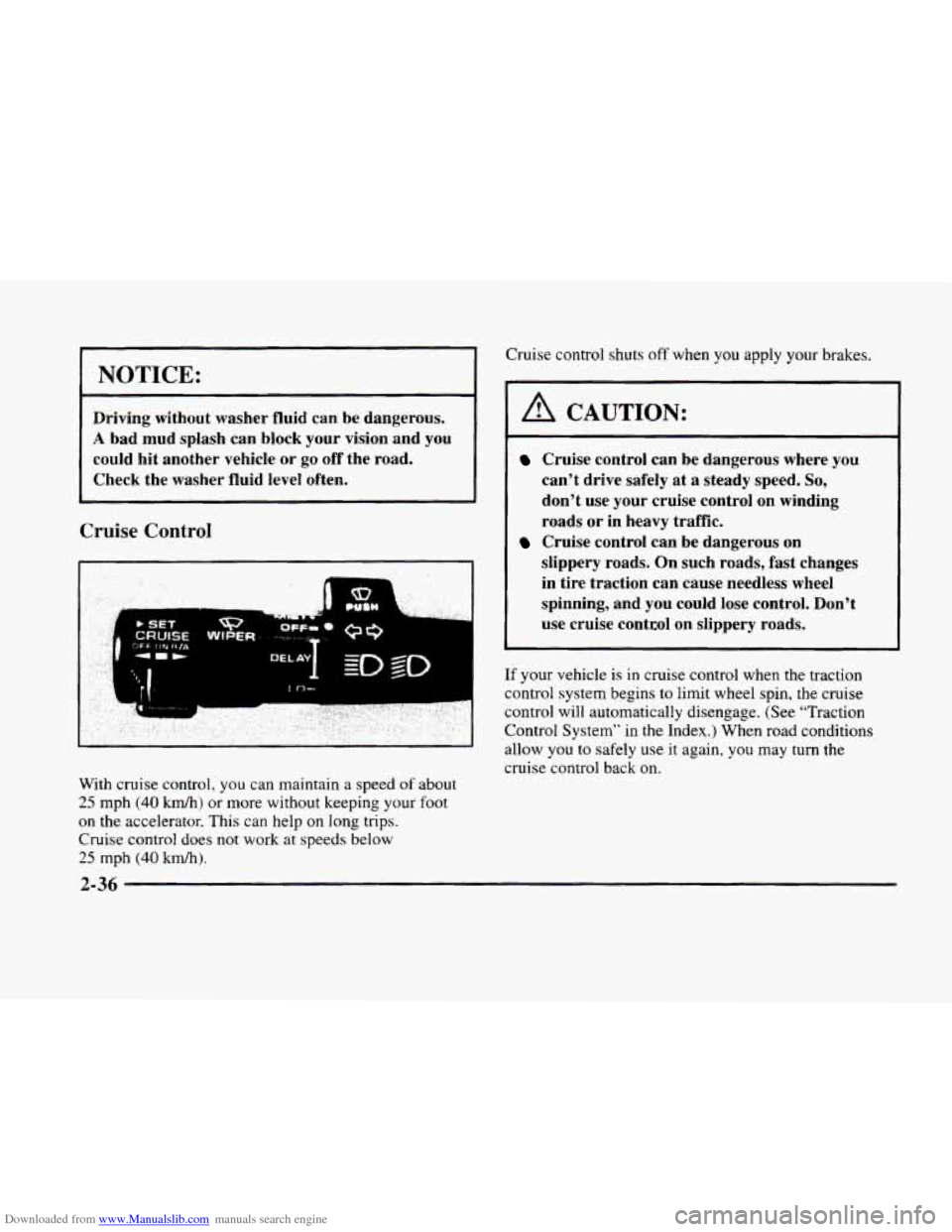
Downloaded from www.Manualslib.com manuals search engine NOTICE:
Driving without washer fluid can be dangerous.
A bad mud splash can block your vision and you
could hit another vehicle or go off the road.
Check the washer fluid level often.
J
Cruise Control
With cruise control, you can maintain a speed of about
25 mph (40 km/h) or more without keeping your foot
on the accelerator. This can help on long trips.
Cruise control does
not work at speeds below
25 mph (40 kd).
Cruise control shuts off when you apply your brakes.
A CAUTION:
Cruise control can be dangerous where you
can’t drive safely at
a steady speed. So,
don’t use your cruise control on winding
roads or in heavy traffic.
slippery roads. On such roads, fast changes
in tire traction can cause needless wheel
spinning, and you could
lose control. Don’t
use cruise control on slippery roads.
Cruise control can be dangerous on
If your vehicle is in cruise control when the traction
control system begins
to limit wheel spin, the cruise
control will automatically disengage. (See “Traction
Control System” in
the Index.) When road conditions
allow you
to safely use it again, you may turn the
cruise control back
on.
2-36